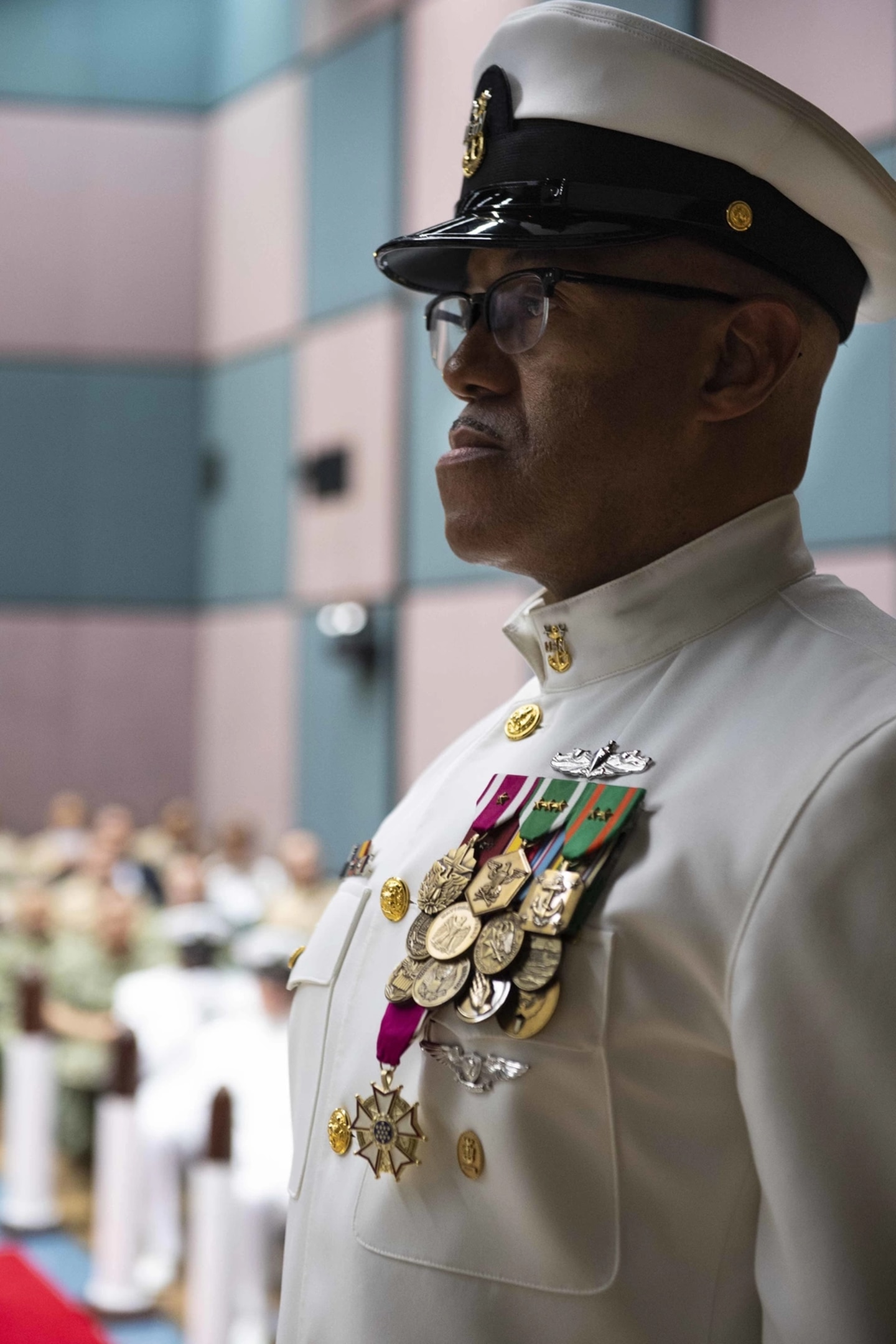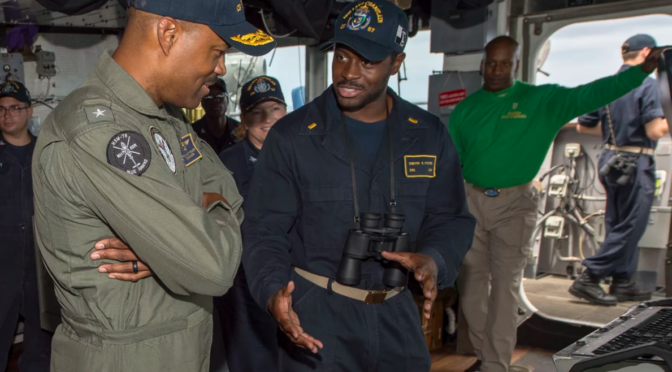By Captain John Cordle, (ret.), and LCDR Reuben Keith Green, (ret.)
Human Capital; Humane Capitulation
“Most Americans associate the strength of the Navy with grey-hulled ships at sea, but the true sources of our naval power are the people and the loved ones who support them.” These are the words of Chief of Naval Operations Admiral Mike Gilday, speaking to lawmakers on Capitol Hill at his nomination hearing. As today’s military looks toward possible future conflicts with peer competitors, one thing we will need more than anything else is the best people. With recruiting challenges driving unprecedented measures such as significant signing bonuses, the Department of Defense needs to look to existing policies and practices that act as barriers to recruiting and retaining the right mix of servicemembers – irrespective of race or gender.
There is a major battle underway between those who support Diversity, Equity, and Inclusion (DEI) initiatives and those who see them as divisive. The irony is that true DEI does not mean “more minorities,” but a diverse force that creates a culture where everyone has an equal chance of success. It is a fantasy to believe that a meritocracy is purely objective and devoid of bias, both explicit and subconscious. After attending a series of DEI symposia over the past year, we have built a series of recommendations, some of which would cost little to nothing, but each of which would very likely attract and keep more of the critical human capital needed to keep our nation safe.
People Issues, Policy Issues
Following the shocking murder of George Floyd and the lynching of Ahmaud Arbery, there were world-wide condemnations, soul-searching, introspection, and acknowledgement of shortcomings, as well as commitments to change. Those reactions occurred within the Department of Defense as well. Military personnel shared their experiences with discrimination and racism, including the current Chief of Staff of the Air Force, a retired four-star Navy admiral, and numerous mid-level active duty and retired officers from multiple services. Military personnel involved in focus group discussions yelled at each other from different sides of the racial divides, and the Air Force received 27,000 single-spaced pages of data after requesting stories of discrimination from their members. Symposiums were held, reports were commissioned and completed, programs were put in place, and accountability was fixed for progress.
But as with each period of progress toward true equity and inclusion, there was resistance, denial, and indecision as to how far to go. For the average servicemember, the most visible change was the banishment of offensive symbology from military bases, and name changes for nine Army bases named for Confederate figures (but oddly, no similar changes for two ships – more on this later). These changes were not without pushback and resistance, including from the then-Commander-in-Chief, but they are happening now. While the demise of Camp Nathan Bedford Forrest and USS Josephus Daniels occurred organically, the other more recent changes did not. Forrest fought for the Confederacy and was a feared slave trader and breaker, and is credited with founding the Ku Klux Klan, a terrorist group. Daniels was a newspaperman who masterminded the infamous 1898 Wilmington North Carolina Insurrection, and also served as Secretary of the Navy 20 years later.
These entities are long gone, passed to history, but other problematic names adorn two aircraft carriers – the USS John S. Stennis, a segregationist (read: racist) who led the Southern “Dixiecrats” as a Mississippi senator, and who called his senate office conference table “The Flagship of the Confederacy.” The USS Carl Vinson is named after another representative cut from a similar cloth. While many have forgotten the behavior and policies that made these men soldiers of segregation, the minority Sailors serving on these ships must feel a bit uneasy as they walk across the quarterdeck, if they know the history. Those individuals may have been helpful to the Navy in certain respects, but they are relics of a past that we can address, not erase – and send a clear and powerful message of inclusion.

Two years hence, it is time to look at what low-hanging fruit remains, based upon the reported experiences of servicemembers currently serving our nation. According to a DOD survey, fully one third of our minority servicemembers have reported racist, extremist, and harassing behavior having been directed at them, and no specific new guidance has been provided to them or increase in accountability for the offenders announced or codified. Numerous reports have been published about the ongoing issues of racism and discrimination in the military, as reported in stories by the Associated Press, Reuters, and other organizations. Congressional studies and research from the Center for Naval Analyses have shown increases in violent extremism, even while some call for the DOD to cease talking about it. Those reports have largely gone unanswered by cognizant authorities. Conversely, the Department of Defense removed the statistics regarding formal discrimination complaints from the historical Annual Defense Reports, and that data is now difficult to obtain and assess. Despite having been outlawed in 1948 by executive order, racist actions and behavior do not have a separate offense category under the Uniform Code of Military Justice, resulting in (according to a 2021 Center for Naval Analyses study on the topic), a quandary in that “the data quality is too poor to make a true assessment.” But that does not mean there is nothing to assess.
Some discriminatory polices remain, if nuanced and unintended. Male servicemembers suffering from Pseudofolliculitis Barbae (PFB) in all branches of the service have repeatedly faced harassment, disrespect, delayed promotions, and other adverse impact because of a permanent, genetic condition beyond their control. PFB is a skin condition that results in inflammation caused by ingrown hairs, typically around the face and beard areas, making it challenging and painful for individuals with PFB to consistently maintain a close shave. It afflicts 50 to 75 percent of blacks and 3 to 5 percent of whites who shave. Studies have shown individuals with PFB suffer a negative impact on promotion and advancement opportunities that negatively impact their careers, not to mention the psychological impact on individuals being singled out and disrespected on account of an approved treatment for a medical condition which can easily be rectified by growing a short beard, something that has occurred in the Navy and in the Army in the past.

Other than “tradition,” there is little justifiable reason to allow this situation and its discriminatory impact on a significant portion of the military to continue. The recruiting woes facing all the services can be addressed in a positive manner by making it less painful and difficult to serve. Would the policy change if a majority of white men were affected by this painful condition?

A recurring complaint expressed by many servicemembers is the lack of respect shown them in their daily lives while serving in uniform. A recent Joint Women’s Leadership Symposium featured discussions of sexual harassment; a female servicemember has a one in three change of being sexually harassed within the next year, and an 85 percent chance in her career. Sexual assaults at the service academies are up again for the past year.
Many of the problems mentioned here are reflections of a society that still struggles with concepts like racism, sexism, prejudice, or their opposites. To many, the implication of institutional bias, even when supported by data and facts, is seen as a personal affront. The institution is a reflection of its members – unlike larger society, which is stuck with some portion of biased or criminal members, the military can impact its own composition by seeking out and separating them. We cannot easily change minds – but we can change behavior. A good parallel can be drawn between the culture change that has resulted in better definition and understanding of the spectrum of harm associated with sexual harassment to sexual assault, and that of racism or discrimination to violent extremism. The former has outpaced the latter, but also laid a solid foundation upon which to build.
Recommendations
What specific actions do we recommend? Stop addressing the issues one service at a time and create a coherent DOD strategy to include multiple steps that address challenges in a multi-faceted way.
1. The department should review and synthesize the plethora of past studies and reports and assess what has changed and what has not. The USFF Comprehensive Review of Surface Collisions provided an excellent template for this process, looking back over two decades of reports and studies as part of its assessment.
2. Reinstate the requirement to report and release the formal military discrimination complaint statistics on an annual basis and provide the historical reports that have been hidden thus far from public view. Include the number of reports, and how many were found to be substantiated and unsubstantiated, to facilitate trend analysis and eliminate poor data quality which has existed for decades.
3. Publish diversity studies and research in a readable, data-based format for public and servicemember understanding, rather than bury studies in a limited academic forum or format with no context.
4. Continue to provide education and review policies that present barriers to reporting sexual and racial discrimination, such as SECNAV’s recent policy to not prosecute minor infractions (such as underage drinking or UA) on the part of victims that report an assault, and assigning investigators outside the chain of command. Make these DOD policy.
5. Add “Respect” to the core values of each service, and to the Department of Defense. Accompany this with education on what it means to respect your peers, subordinates, and your service with concrete behavior. Start the conversation, spread best practices, and send a signal.
6. Rename the USS John C. Stennis and USS Carl Vinson, so that not one more generation of Black sailors has to face the prospect of serving on a ship named for individuals who focused on ensuring they were held to second class status as citizens and servicemembers. There are plenty of deserving heroes of all races that could serve as more fitting names for the U.S. Navy’s warships.
7. Revise the policies regarding facial hair to reflect a more equitable treatment of servicemembers afflicted with PFB. Allow short, well-trimmed beards for all servicemembers.
8. Create a DOD Women’s Policy Board, comprised of officer, enlisted, and civilian members, to provide DOD leadership with recommendations regarding issues relating to females serving within the department, and as a clearing house for problems to be addressed once identified.
9. Add a Uniform Code of Military Justice offense of “racist actions and behavior” so that each individual understands that they can be held accountable for such behavior. A database can be developed on recorded offenses and inform desired change. Publish the results to show accountability at work.
10. Establish a permanent DOD and GAO review process similar to Task Force One Navy, not as a one-time reaction with a singular focus, but as an enduring process that provides an annual report on diversity, equity, and inclusion policies and action items. It should note progress, or lack thereof.
Conclusion
The most frequent DOD response to most of these items in the past has been “no comment.” This must change. These 10 actions would require education, learning, and – most importantly – empathy, on the part of both junior and senior leaders. But they can all be completed in short order, with little relative cost, and will pay huge dividends. If taken, each of them will improve not just diversity, equity, and inclusion, but will have a lasting impact on retention, morale, unit cohesion, and advancement of all servicemembers. Just as importantly, by investing in our human capital – our people – the long term impacts will be seen where it really counts – a tangible boost in operational readiness and national security.
Captain John Cordle retired from the Navy in 2013 after 30 years of service. He commanded the USS Oscar Austin (DDG-79) and USS San Jacinto (CG-56), retiring as Chief of Staff for Commander, Naval Surface Forces Atlantic. He received the U.S. Navy League’s Captain John Paul Jones Award for Inspirational Leadership in 2010, the Surface Navy Literary Award, and Naval Institute Proceedings Author of the Year Award in 2019. Recently, he has teamed with his co-author, LCDR Green, in an effort to promote diversity and inclusion in the military, authoring several articles and featured as speakers on the topic at various Navy and affinity group DEI symposia over the past two years.
Lieutenant Commander Keith Green retired in 1997 after serving 22 years in the Navy. He served four department head tours, including as Executive Officer in USS Gemini (PHM-6). He is a former Legal Yeoman, Equal Opportunity Program Specialist, and leadership Instructor, and was commissioned in 1984 via Officer Candidate School. He has an MS degree in Human Resources Development. His memoir Black Officer,White Navy was acquired by a University Press and a revised edition will be republished in 2023.
Featured Image: Rear Adm. Alvin Holsey (left) speaks with Ensign Dimitri Foster in the pilothouse aboard guided-missile cruiser USS Lake Champlain in 2018. (Photo by Petty Officer 2nd Class Craig Rodarte/U.S. Navy)


Well written, well researched, and well planned. What’s needed most of all it needs to be well executed if we are expected to win the next conflict or war. Diversity, Equity, and Inclusion (DEI) initiatives should be incorporated into the public and public sectors too.
A minor correction to recommendation #5. Respect is one of the seven (7) Core Values of the United States Army: Loyalty, Duty, Respect, Selfless Service, Honor, Integrity, and Personal Courage (LDRSHIP). That can be found in GTA 22-06-004 .
Personally, I always thought beards, as long as they were maintained to a standard, should never have been taken from the service. Having a beard could probably solve some of the issues with morale. Beards are allowed in the navies of some of our NATO allies.
Respectfully,
Thanks for reading it! As I understand it, Army and Coast Guard have Respect as a core value – hoping the Navy and Marine Corps will follow suit!
Great article. Thank you both for taking your valuable time to educate us. Our people are our most important asset and we definitely must continue to find ways to make our work environment better and to also educate everyone on challenges faced throughout our forces. Only through actions supported by our leaders and the people they lead will drive the change needed to make us an even stronger force!
Thank you so much for this article. I am curious how do we get involved in these changes? I may have missed it in the article.